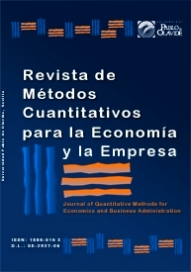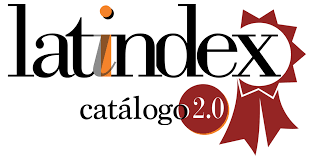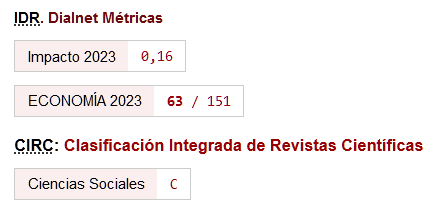Fomentando la inclusión financiera global mediante mejoras integradas en la alfabetización financiera y tecnológica. Un análisis de datos de panel
DOI:
https://doi.org/10.46661/rev.metodoscuant.econ.empresa.9441Palabras clave:
Inclusión Financiera, Alfabetización Tecnológica y Financiera, Información Asimétrica, Datos de PanelResumen
La inclusión financiera es esencial para el desarrollo económico, al proporcionar servicios fundamentales como cuentas de ahorro, crédito y seguros. A pesar de su relevancia, de acuerdo a datos del Banco Mundial, cerca de 1.5 mil millones de adultos en el mundo no tienen acceso a una cuenta bancaria formal y casi 2 mil millones no son sujetos de crédito, la mayoría en países en desarrollo. Ello limita sus oportunidades económicas y perpetúa la desigualdad. Promover la inclusión financiera es crucial para impulsar un crecimiento económico sostenible, mejorar la igualdad de oportunidades y fortalecer la resiliencia financiera de un país frente a estos tiempos turbulentos. La alfabetización financiera y tecnológica desempeña un papel fundamental en impulsarla. Dotar a los individuos de estas habilidades les permite tomar decisiones informadas y utilizar eficazmente los servicios financieros digitales. Esta investigación proporciona evidencia cuantitativa, a través de estimaciones con datos panel, sobre la importancia de la alfabetización tecnológica y financiera en la determinación de la inclusión financiera, junto con la educación. También revela que, por el lado de la oferta, una infraestructura sólida para los servicios financieros digitales, especialmente a través de los teléfonos móviles, promueve el ahorro y el crédito. También es crucial mitigar el impacto de la información asimétrica, característica del sector financiero, a través de burós de crédito. Por el lado de la demanda, tanto las competencias digitales y financieras, como la resiliencia laboral, tienen una correlación positiva con la inclusión financiera. Los atributos institucionales de un país también son fundamentales.
Descargas
Citas
Alahi, M. E. E., Sukkuea, A., Tina, F. W., Nag, A., Kurdthongmee, W., Suwannarat, K. & Mukhopadhyay, S. C. (2023). Integration of IoT-Enabled Technologies and Artificial Intelligence (AI) for Smart City Scenario: Recent Advancements and Future Trends. Sensors, 23(11), 5206. MDPI AG. https://doi.org/10.3390/s23115206
Armstrong, S. & Collopy, F. (1993). Causal Forces: Structuring Knowledge for Time-Series Extrapolation. Journal of Forecasting 12, 103-115. https://doi.org/10.1016/0169-2070(92)90008-W
Ashenafi, F. & Kingstone, M. (2021). Financial Literacy as a Driver of Financial Inclusion in Kenya and Tanzania. Journal of Risk and Financial Management 14, 561. https://doi.org/10.3390/jrfm14110561
Atkinson, A. & Messy, F. (2013). Promoting Financial Inclusion through Financial Education: OECD/INFE Evidence, Policies and Practice. OECD Working Papers on Finance, Insurance and Private Pensions, No. 34, OECD Publishing, https://doi.org/10.1787/5k3xz6m88smp-en
Bagehot, W. (1873). Lombard Street: A Description of the Money Market. New York, NY: Scribner, Armstong & Co.
Beck, T., Demirgüç-Kunt, A., & Levine, R. (2007). Finance, Inequality, and the Poor. Journal of Economic Growth 12(1), 27-49. https://doi.org/10.1007/s10887-007-9010-6
Bottazzi, L. & Lusardi, A. (2021) Stereotypes in Financial Literacy: Evidence from PISA. Journal of Corporate Finance 71, 101831. https://doi.org/10.1016/j.jcorpfin.2020.101831
Cole, S., Sampson, T. & Zia, B. (2011). Prices or Knowledge? What Drives Demand for Financial Services in Emerging Markets? The Journal of Finance, 66(6), 1933-1967. https://doi.org/10.1111/j.1540-6261.2011.01696.x
Demirgüç-Kunt, A.; Klapper, L.; Singer, D. and Ansar, S. (2021). The Global Findex Database 2021 Financial Inclusion, Digital Payments, and Resilience in the Age of COVID-19. World Bank Group. Retrieved from: https://doi.org/10.1596/978-1-4648-1897-4
European Commission (2022). The Digital Economy and Society Index (DESI). Retrieved from: https://digital-strategy.ec.europa.eu/en/policies/desi
Fungáčová, R. & Weill, L. (2016). Reserve Requirements and the Bank Lending Channel in China. Journal of Macroeconomics, 50, 37-50. https://doi.org/10.1016/j.jmacro.2016.08.007
Girma, S. & Shortland, A. (2008). The Political Economy of the Financial Development. Oxford Economic Papers, 60, 567-596. https://doi.org/10.1093/oep/gpm040
Goyal, K. & Kumar, S. (2020). Financial Literacy: A Systematic Review and Bibliometric Analysis. International Journal of Consumer Studies, 45(1), 80-105. https://doi.org/10.1111/ijcs.12605
Greenwald, B., Stiglitz, J. & Weiss, A. (1984). Informational Imperfections in the Capital Market and Macro-Economic Fluctuations, American Economic Review Vol. 74, No. 2, 194-199.https://doi.org/10.3386/w1335
Gudjonsson, S., Minelgaite, I., Kristinsson, K., & Pálsdóttir, S. (2022). Financial Literacy and Gender Differences: Women Choose People While Men Choose Things? Administrative Sciences, 12(4), 179. https://doi.org/10.3390/admsci12040179
Hyman, L. (2016) Temps, Consultants, and the Rise of the Precarious Economy, The Hedgehog Review, Vol. 18, No. 1, 17-32.
Hoffmann, S. (2001) Politics and Banking. Ideas, Public Policy, and the Creation of Financial Institutions. Johns Hopkins University Press.
Holzmann, R. (2010). Bringing Financial Literacy and Education to Low and Middle-Income. Countries, Pension Research Council WP, Vol. 38, https://doi.org/10.2139/ssrn.1707673
ILO, International Labour Organization (2023). ILOSTAT database. Retrieved from: https://ilostat.ilo.org/data/
IMF, International Monetary Fund (2023). Financial Access Survey (FAS). https://data.imf.org/?sk=e5dcab7e-a5ca-4892-a6ea-598b5463a34c.
ITU, International Telecommunication Union (2023), World Telecommunication/ICT Indicators Database. Retrieved from https://www.itu.int/en/ITU-D/Statistics/Pages/publications/wtid.aspx.
ITU, International Telecommunication Union (2022). Measuring digital development Facts and figures 2020. Telecommunication Development Sector ITU Publications. https://www.itu.int/itu-d/reports/statistics/facts-figures-2022/
Jariwala, H. & Sharma, S. (2011). Financial Literacy: A Call for an Attention. International Journal of Academic Conference Proceedings, 1(1), Proceedings of Conference on Inclusive and Sustainable Growth.
Kaiser, T. & Menkhoff, L. (2017). Does Financial Education Impact Financial Literacy and Financial Behavior, and If So, When? The World Bank Economic Review 31(3), 611-630. https://doi.org/10.1093/wber/lhx018
Kaufmann, D., Kraay, A. & Mastruzzi, M. (2010). The Worldwide Governance Indicators: Methodology and Analytical Issues. World Bank Policy Research Working Paper No. 5430
Khan, F., Siddiqui, M. & Salma, I. (2022). Role of Financial Literacy in Achieving Financial Inclusion: A Review, Synthesis and Research Agenda. Cogent Business & Management, 9, 2034236.https://doi.org/10.1080/23311975.2022.2034236
Kim, D.-W., Yu, J.-S. & Hassan, M. K. (2018). Financial inclusion and economic growth in OIC countries. Research in International Business and Finance, 43, 1-14. https://doi.org/10.1016/j.ribaf.2017.07.178
Klapper, L, Lusardi, A. (2020). Financial Literacy and Financial Resilience (2020): Evidence from Around the World. Financial Management, 49, 589-614. https://doi.org/10.1111/fima.12283
Klapper, L., Lusardi, A. & Van Oudheusden P. (2015). Financial Literacy Around the World: Insights from the Standard & Poor's Rating Services. Global Financial Literacy Survey. World Bank Development Research Group.
Kling, J., Liebman, J. & Katz, L. (2007). Experimental Analysis of Neighborhood Effects, Econometrica, 75(1), 83-119.https://doi.org/10.1111/j.1468-0262.2007.00733.x
Kmenta, J. (1997). Elements of Econometrics. 2nd ed. Ann Arbor: University of Michigan Press, 127.https://doi.org/10.3998/mpub.15701
Königsheim, Ch., Lukas, M. & Nöth, M. (2017). Financial Knowledge, Risk Preferences, and the Demand for Digital Financial Services. Schmalenbach Business Review, 18(4), 343-375.https://doi.org/10.1007/s41464-017-0040-0
Lenka S. & Barik, R. (2018). Has the Expansion of Mobile Phone and Internet Use Spurred Financial Inclusion in the SAARC Countries? Financial Innovation 4(1), 1-19https://doi.org/10.1186/s40854-018-0089-x
Levine, R. (1991). Stock Markets, Growth, and Tax Policy. Journal of Finance, 46(4), 1445-1465. https://doi.org/10.1111/j.1540-6261.1991.tb04625.x
Lucas, R. (1988). On the Mechanics of Economic Development. Journal of Monetary Economics 22 (1). July, 3-42https://doi.org/10.1016/0304-3932(88)90168-7
Lusardi, A. & Mitchell, O. S. (2014). The Economic Importance of Financial Literacy: Theory and evidence. Journal of Economic Literature, 52(1), 5-44.https://doi.org/10.1257/jel.52.1.5
McKinnon, R. (1973). Money and Capital in Economic Development. The Brookings Institutions, Washington, D.C.
Milian, E. Z., Spinola, M. D. M. & de Carvalho, M. M. (2019). Fintechs: A Literature Review and Research Agenda. Electronic Commerce Research and Applications, 34, 100833. https://doi.org/10.1016/j.elerap.2019.100833
Minsky, H. (1982). Inflation, Recession and Economic Policy, Brighton, Wheatsheaf.
OECD, Organization for Economic Cooperation and Development (2022). INFE Toolkit for Measuring Financial Literacy and Financial Inclusion. https://www.oecd.org/ financial/education/2022-INFE-Toolkit-Measuring-Finlit-Financial-Inclusion.pdf
Parasuraman, A. (2000). Technology Readiness Index (Tri): A Multiple-Item Scale to Measure Readiness to Embrace New Technologies. Journal of Service Research, 2(4), 307-320. https://doi.org/10.1177/109467050024001
Pavón, L. (2018). International Financial Inclusion: Some Multidimensional Determinants. Small Business International Review, SBIR, 2 (2), 1-14, https://doi.org/10.26784/sbir.v2i2.125
Pavón, L. (2021). Financial Inclusion as a Pillar of Sustainable Growth: International Experience. Economic Horizons, 2021, 23(2), 105-118.
https://doi.org/10.5937/ekonhor2102107P
Pavón, L. (2024). The Importance of Social Capital in Promoting Financial Inclusion: An International Perspective. Scientific Annals of Economics and Business, 71(2), 221-240. https://doi.org/10.47743/saeb-2024-0013
Purba, J., Hery, H. & Lestari, V. (2019). Financial Technology Readiness: Strategic Innovation Management in the Service Industry 4.0. Proceedings of the 1st Asian Conference on Humanities, Industry, and Technology for Society, ACHITS 2019, 30-31 July 2019, Surabaya, Indonesia. https://doi.org/10.4108/eai.30-7-2019.2287760
Rebelo, S. (1991). Long-Run Policy Analysis and Long-Run Growth, Journal of Political Economy, 99(3), 500-521. https://doi.org/10.1086/261764
Rillo A. (2014). Overview of Financial Inclusion in Asia. In Asian Development Bank Institute and Asia-Pacific Finance and Development Centre. Country Surveys; ADB: Tokyo, Japan.
Romer, P. M. (1990). Human Capital and Growth: Theory and Evidence. Carnegie-Rochester Conference Series on Public Policy, 32, 251-286. https://doi.org/10.1016/0167-2231(90)90028-J
Samuelson, P. & Nordhaus, W. (2010). Economía, con Aplicaciones para Latinoamérica, 19ª edición. Pavón, L., Blanco, C. Rev, Mc Graw Hill, Mexico City.
Schumpeter J. (1934). Theory of Economic Development: An Inquiry into Profits, Capital, Credit, Interest, and the Business Cycle. Harvard University Press, Cambridge, MA.
Silgoner, Z, Shen, Y., Hu, W. & Hueng, J. (2018). The Effects of Financial Literacy, Digital Financial Product Usage, and Internet Usage on Financial Inclusion in China. MATEC Web of Conferences 228, 05012 https://doi.org/10.1051/matecconf/ 201822805012
Solow, R. (1956). A Contribution to the Theory of Economic Growth. The Quarterly Journal of Economics, 70(1), 65-94, https://doi.org/10.2307/1884513
Standard & Poor's Ratings Services Global FinLit Survey (2016). Retrieved from: https://gflec.org/initiatives/sp-global-finlit-survey/
Stata (2019). Stata 16 Manuals: Longitudinal Data/ Panel Data Reference Manual. Stata Press, College Station, Texas, 313-372.
Swan, T. (1956). Economic Growth and Capital Accumulation. Economic Record, 32(2), 334-361. https://doi.org/10.1111/j.1475-4932.1956.tb00434.x
United Nations (2015). Sustainable Development Goals. Retrieved from: https://www.un.org/sustainabledevelopment/development-agenda/
U.S. Department of the Treasury (2018). A Financial System That Creates Economic Opportunities Nonbank Financials, Fintech, and Innovation, U.S. Department of the Treasury, https://home.treasury.gov/sites/default/files/2018-08/
WB, World Bank (2023a). DataBank. Retrieved from: https://databank.worldbank.org/
WB, World Bank (2023b). SDG Indicators Metadata repository Goal 4: Quality education. Retrieved from:https://unstats.un.org/sdgs/metadata/
WB, World Bank (2021). The Global Findex Database. Retrieved from: https://www.worldbank.org/en/publication/globalfindex/Data
Yan Sh., Hueng, J. & Hua, W. (2020). Using Digital Technology to Improve Financial Inclusion in China. Applied Economic Letters, 27(1), 30-34. https://doi.org/10.1080/13504851.2019.1606401
Descargas
Publicado
Cómo citar
Número
Sección
Licencia
Derechos de autor 2024 Lilianne Isabel Pavón Cuéllar

Esta obra está bajo una licencia internacional Creative Commons Atribución-CompartirIgual 4.0.
El envío de un manuscrito a la Revista supone que el trabajo no ha sido publicado anteriormente (excepto en la forma de un abstract o como parte de una tesis), que no está bajo consideración para su publicación en ninguna otra revista o editorial y que, en caso de aceptación, los autores están conforme con la transferencia automática del copyright a la Revista para su publicación y difusión. Los autores retendrán los derechos de autor para usar y compartir su artículo con un uso personal, institucional o con fines docentes; igualmente retiene los derechos de patente, de marca registrada (en caso de que sean aplicables) o derechos morales de autor (incluyendo los datos de investigación).
Los artículos publicados en la Revista están sujetos a la licencia Creative Commons CC-BY-SA de tipo Reconocimiento-CompartirIgual. Se permite el uso comercial de la obra, reconociendo su autoría, y de las posibles obras derivadas, la distribución de las cuales se debe hacer con una licencia igual a la que regula la obra original.
Hasta el volumen 21 se ha estado empleando la versión de licencia CC-BY-SA 3.0 ES y se ha comenzado a usar la versión CC-BY-SA 4.0 desde el volumen 22.










